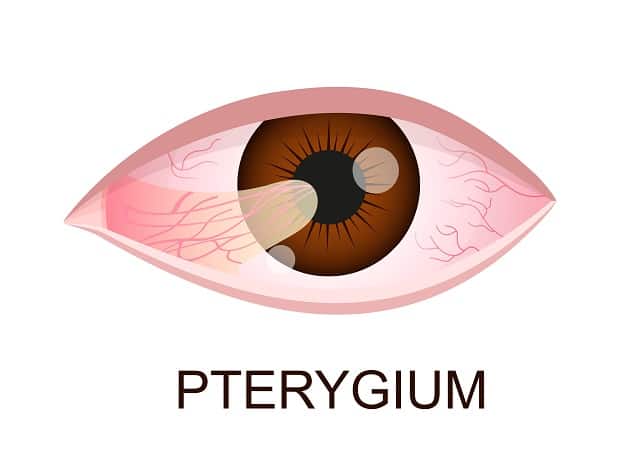
Pterygium Surgery For
St. Petersburg & Clearwater, FL
What is a Pterygium
Pterygium is a white, red, pink or yellow flesh-like tissue growth on the clear mucous membrane (conjunctiva) covering your eyelids and eyeball. This eye condition is common among people who spend much of their lives under the sun, including farmers, fishers and surfers. Pterygium is nicknamed “surfer’s eye.”
The tinged growth spreads across the white section of your eye and can cover the cornea (the clear surface over the iris and pupil responsible for focusing light). You may see blood vessels spreading through the growth, which can develop on one or both eyes.
Many people with pterygium don’t require treatment, but if the tissue growth impacts your vision or comfort, St. Michael’s Eye & Laser Institute can help.

What Causes “Surfer’s Eye?”
Pterygium is not cancer, and its cause is unknown. Researchers believe environmental exposures such as wind, dust and UV light play a big part in pterygium development, but you don’t have to be a surfer to get “surfer’s eye.” You may not experience any symptoms, but the growth may cause you to have some cosmetic concerns. Pterygium symptoms may be mild to severe and include:
- Dry, itchy or burning eyes
- Gritty feeling in your eyes or a sense there’s sand in your eyes
- Conjunctiva swelling
- Blurred vision
- Bump or yellow spot on the white of the eye
- Changes in appearance of the eye
- Astigmatism

Who’s At Risk For Pterygium?
People who work outdoors or in dusty conditions are more likely to develop pterygium. The condition is most common in tropical regions and often grows over months or years. Sometimes pterygium is preceded by pinguecula, a yellowish, raised conjunctiva growth on the side of the eye. The growth typically appears near the inner corner of the eye by the nose and is caused by protein, fat or calcium deposits. Both changes are more prevalent in those who spend most of their time in the sun or in windy, dusty environments.

How To Prevent Pterygium
You can lower your risk of “surfer’s eye” by wearing sunglasses to protect yourself from harmful UVA and UVB rays. Your prescription glasses can also be coated with UV protectant, and a wrap-around glasses design can lower exposure. Wear goggles in windy or dusty areas such as carpentry shops and use artificial tears when your eyes feel dry.

Pterygium Diagnosis And Treatment
Pterygium is diagnosed during a comprehensive eye exam using a special microscope and light called a slit lamp that allows our Ophthalmologists to look closely at the front structures of the eye. The extent of tissue growth is examined from the white portion onto the cornea. Most “surfer’s eye” cases don’t require treatment, but if you have uncomfortable symptoms such as dry or irritated eyes, lubricating eye drops or steroidal eye drops can help. Artificial tears, ointments and gels may also ease pterygium symptoms.
Pterygium Surgery
If your vision is severely affected, our Ophthalmologists may recommend surgery to remove the growth and transplant a thin tissue section onto the affected area to prevent the pterygium from growing back. Surgery is reserved for serious cases as pterygium may resurface, but the risk is lowered if you avoid sunlight, dry eyes and dust particles.
Contact St. Michael’s Eye & Laser Institute
Contact our Ophthalmologists to learn more about pterygium and schedule an eye exam at our Largo office to investigate your symptoms.
 Patient Portal
Patient Portal  Online Payment
Online Payment  Doctor Referral
Doctor Referral  Financing
Financing 

